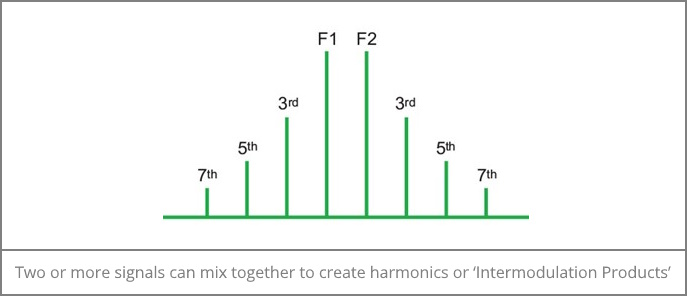Advanced wireless networks such as those employing 4G and 5G technology offer significant improvements in terms of speed, capacity, and latency for mobile communication. However, these technologies are more susceptible to interference, which can reduce data throughput and impact service quality.
Intermodulation happens when two or more signals at different frequencies interact nonlinearly to create additional frequencies that were not part of the original transmitted signals. These additional frequencies can interfere with the desired communication signals, reducing performance.
Intermodulation interference is a common problem in cellular networks operating in the frequency bands used for LTE (4G) and 5G technologies. It is also present in many other wireless systems such as Wi-Fi and Satellite etc.
Passive Intermodulation ("PIM") is a form of intermodulation distortion that occurs in components normally thought of as linear, such as cables, connectors and antennas. PIM is typically caused by non-linearities in passive components when they are subjected to high-power Radio Frequency ("RF") signals and can generate intermodulation signals which severely impact performance.
PIM can lead to various performance issues in cellular networks, including reduced signal quality, increased dropped calls, decreased data throughput, and degraded network capacity. It can also cause intermittent issues that are challenging to diagnose and resolve.
The increase in spectrum usage, driven in part by the deployment of new wireless bands and technologies such as 4G and 5G, coupled with the growing number of wireless devices, has served to increase the potential for interference. As more wireless base stations operate at multiple frequency bands, there is a greater chance of intermodulation interference occurring. With more transmitters in close proximity, the likelihood of these interactions increases.
To maximize spectrum utilization and network capacity, wireless networks often employ frequency reuse strategies. However, improper planning can lead to intermodulation interference, or the presence of PIM in networks can limit the frequency bands which can be deployed in any given area reducing spectral efficiency and increasing deployment cost. Careful network design and interference mitigation techniques are essential to minimize these issues.
As spectrum usage continues to increase and new radio systems and technologies such as cellular, Wi-Fi and Satellite are deployed, the potential for intra-system and inter-system intermodulation interference also grows. To address these challenges, a combination of advanced interference mitigation technologies, spectrum management strategies, and regulatory measures is essential to ensure the coexistence of multiple wireless services and technologies in the limited radio frequency spectrum available, and to minimize disruptions of wireless communication services.
